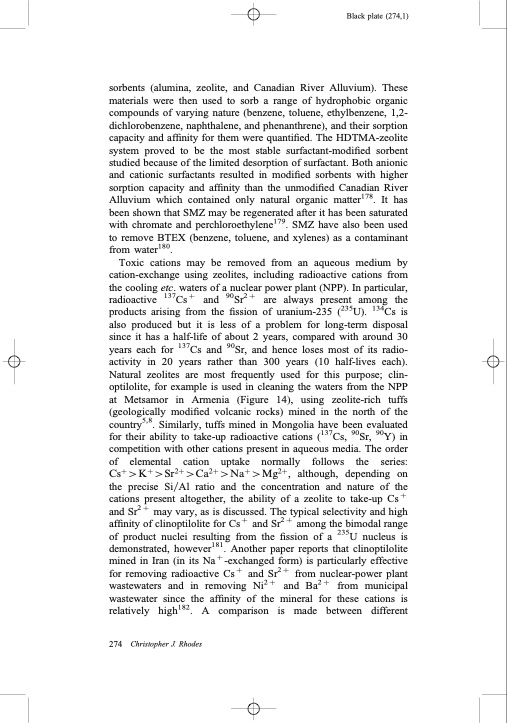
PDF Publication Title:
Text from PDF Page: 052
Black plate (274,1) sorbents (alumina, zeolite, and Canadian River Alluvium). These materials were then used to sorb a range of hydrophobic organic compounds of varying nature (benzene, toluene, ethylbenzene, 1,2- dichlorobenzene, naphthalene, and phenanthrene), and their sorption capacity and affinity for them were quantified. The HDTMA-zeolite system proved to be the most stable surfactant-modified sorbent studied because of the limited desorption of surfactant. Both anionic and cationic surfactants resulted in modified sorbents with higher sorption capacity and affinity than the unmodified Canadian River Alluvium which contained only natural organic matter178. It has been shown that SMZ may be regenerated after it has been saturated with chromate and perchloroethylene179. SMZ have also been used to remove BTEX (benzene, toluene, and xylenes) as a contaminant from water180. Toxic cations may be removed from an aqueous medium by cation-exchange using zeolites, including radioactive cations from the cooling etc. waters of a nuclear power plant (NPP). In particular, radioactive 137Cs þ and 90Sr2 þ are always present among the products arising from the fission of uranium-235 (235U). 134Cs is also produced but it is less of a problem for long-term disposal since it has a half-life of about 2 years, compared with around 30 years each for 137Cs and 90Sr, and hence loses most of its radio- activity in 20 years rather than 300 years (10 half-lives each). Natural zeolites are most frequently used for this purpose; clin- optilolite, for example is used in cleaning the waters from the NPP at Metsamor in Armenia (Figure 14), using zeolite-rich tuffs (geologically modified volcanic rocks) mined in the north of the country5,8. Similarly, tuffs mined in Mongolia have been evaluated for their ability to take-up radioactive cations (137Cs, 90Sr, 90Y) in competition with other cations present in aqueous media. The order of elemental cation uptake normally follows the series: Csþ 4Kþ 4Sr2þ 4Ca2þ 4Naþ 4Mg2þ , although, depending on the precise SiyAl ratio and the concentration and nature of the cations present altogether, the ability of a zeolite to take-up Csþ and Sr2 þ may vary, as is discussed. The typical selectivity and high affinityofclinoptiloliteforCsþ andSr2þ amongthebimodalrange of product nuclei resulting from the fission of a 235U nucleus is demonstrated, however181. Another paper reports that clinoptilolite mined in Iran (in its Na þ -exchanged form) is particularly effective for removing radioactive Cs þ and Sr2 þ from nuclear-power plant wastewaters and in removing Ni2 þ and Ba2 þ from municipal wastewater since the affinity of the mineral for these cations is relatively high182. A comparison is made between different 274 Christopher J. RhodesPDF Image | Properties and applications of zeolites

PDF Search Title:
Properties and applications of zeolitesOriginal File Name Searched:
003685010x12800828155007.pdfDIY PDF Search: Google It | Yahoo | Bing
CO2 Organic Rankine Cycle Experimenter Platform The supercritical CO2 phase change system is both a heat pump and organic rankine cycle which can be used for those purposes and as a supercritical extractor for advanced subcritical and supercritical extraction technology. Uses include producing nanoparticles, precious metal CO2 extraction, lithium battery recycling, and other applications... More Info
Heat Pumps CO2 ORC Heat Pump System Platform More Info
| CONTACT TEL: 608-238-6001 Email: greg@infinityturbine.com | RSS | AMP |